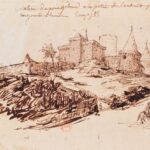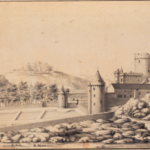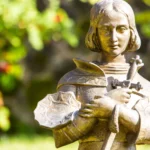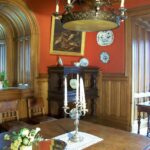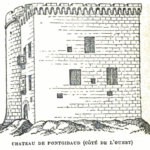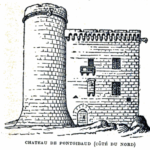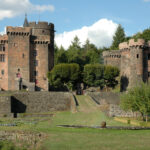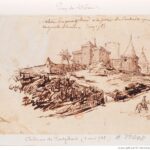Spring in Auvergne is, among other things, the season of castles. From late March to early April, many of these age-old, battlemented estates — like the wildflowers by which they are often encircled — rise in glory from their winter slumber, reopening their doors to the public.
One such castle is the Château Dauphin, a medieval-era fortress located thirty minutes west of Clermont-Ferrand. An ideal attraction for castle-lovers and “castellologists” alike, the Château Dauphin has it all: a storybook keep with crenellated towers, an array of rare paintings, and a sprawling, Renaissance-era garden.



Named after its original owner, Robert Dauphin, the twelfth-century count of Auvergne, the castle has passed through the hands of several families over the centuries. In the mid-eighteenth century it was acquired by the house of Moré de Pontgibaud, which still owns the property today.
To learn more about the Château Dauphin and its unique history and folklore, I spoke with one of its current owners, Françoise, Countess de Germiny.

AM: In your opinion, what is most unique about the chateau?
Françoise de Germiny: Around 1350, Guillaume Motier, seigneur de la Fayette, married Marguerite Brun de Peschin, heiress of Pontgibaud and he became the count of Pontgibaud. Their son Gilbert, was partly brought up at Pontgibaud and became the famous marshal, Gilbert III, counsellor to king Charles VII and comrade in arms to Joan of Arc.
During the Hundred Years War, in 1438, he asked the king to allow him to strengthen his castle. The king agreed and he gave the castle the aspect it has still today after tremendous work. In 1444, the marshal asked the king for permission to fortify the whole village. One of the entrance gates remains today.

A.D. Manns: What is the Château Dauphin’s connection to the La Fayette family?
FG: There’s no connection with our family, which bought the castle from the marshal’s descendants in 1756. The marquess of La Fayette who fought during the American War of Independence belongs to another branch of the La Fayette family, but one of our great-great uncles left Pontgibaud to fight with the marquess against the English and was decorated by General Washington with the Cross of Cincinnatus.
AM: What is your favourite part of the property? Are there any areas in the castle itself or its gardens of which you are particularly fond?
FG: A shelter at the bottom of the garden with chairs where you can sit. Here you can read and contemplate the castle and garden amidst the backdrop of the forest and the setting sun.
In winter, I like sitting in the drawing room by the fireside, which is one of the rare hot places in the castle.
AM: What would you say is the most challenging or difficult aspect of managing the château?
FG: The castle is a fascinating piece of work as far as history is concerned, especially when linked to your family history, as it has been for us since 1756. It’s fascinating for its beauty and its collections, yet it is at the same time a terrific financial challenge. Spending life wondering if we will be able to pay the bills is tiring, despite the help of the state, region, or department…


AM: Is the château associated with any legends or ghost tales?
FG: Yes: the countess Brayère or the “ogress of Pontgibaud”. She was the wife of the Count-Dauphin at the beginning of the thirteenth century and it was rumoured that she ate newborn babies. One day, there was only one left — that of her own cook. Refusing to kill his son, the cook caught a piglet in the yard, cooked it with some spices, and served it. The countess, having finished it, then asked to be served the brain. Recognising it as the brain of an animal, she flew in a violent temper. Then after a very good meal, she decided never to eat a child again and repent. For absolution, she gave lands, including forests and pastures to the poor.
Such is the legend! Today, historians think she was leprous and that story was told to keep children away from her. But she really gave lands…full property to the poor, which was forbidden by the rules of the time and led to many difficulties.




